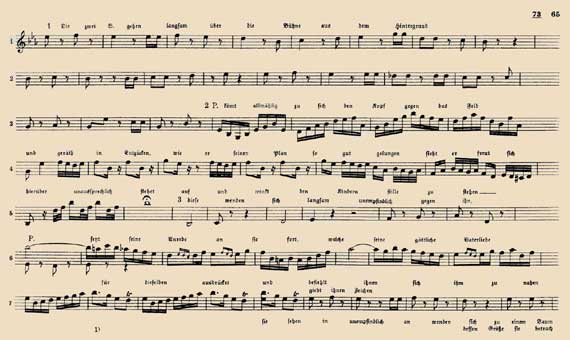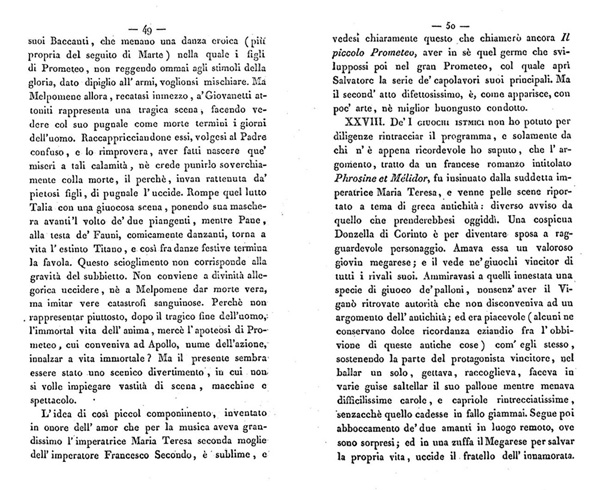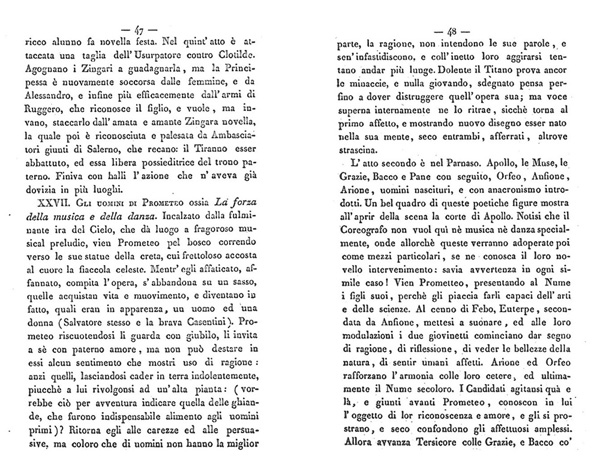Beethoven’s The Creatures of Prometheus, composed in 1801 and published in a piano reduction in 1802, stands as the only independent ballet score produced by a major composer of the nineteenth century until Tchaikovsky composed Swan Lake in 1875. With the possible exception of its Overture, Beethoven’s music for Prometheus has been quite neglected. Whether this is the fault of the scenario or of posterity need not detain us; we must, however, examine the music in detail if we wish to trace the subsequent uses which the composer made of it.
The ballet enjoyed a successful run of 14 performances in 1801 and nine more in 1802, but then was not performed again until 1843.66 A summary of the work through the first nine numbers is given in a now rare biography of Viganò written by Carlo Ritorni and published in 1838, seventeen years after Viganò’s death.67 Ritorni is vague, however, in his description of the action in the last seven numbers of the ballet, and the surviving sketches are equally silent. What little we can know about the final numbers comes from the headings in the working score, and from the contemporary accounts, including a review of the opening night. Published in Zeitung für die elegante Welt I (April 1801), at 485-87, it is significant for noting how far Beethoven’s music, in the critic’s view, had departed from the function which Viganò intended of providing an entertaining divertissement:
“The presentations at our court theater before Easter concluded with a new heroic-allegorical ballet in two acts: Die Geschöpfe des Prometheus, invented and developed by Mr. Salvatore Viganò and set to music by Mr. van Beethoven. The first time, it was given for the benefit of the famous dancer, Miss Casentini. Its content was announced in a very peculiar program, presumably by an Italian not very well versed in the German language.
“Prometheus rescues the people of his time from their ignorance, improves them with knowledge and art, and elevates them to moral awareness. This is the subject in brief. As much dignity and artistic design as it had, and as masterfully as some dancers, most notably Mr. Viganò himself, distinguished themselves, it nevertheless was not liked in general. The least satisfying of all to our spectacle-loving public was the fact that the stage remained completely unchanged from the second scene of the first act until the very end. The action began with a thunderstorm. The theater presented a small grove in which there were two children of Prometheus. Suddenly their father entered with a burning torch. (Where, and with what fire he lighted it, the spectators did not get to see.) After he had placed the fire on the breast of each child, they began at once to toddle around stiffly without gesticulating. (This scene lasted rather too long and became boring.) Now Prometheus led them to Apollo. Parnassus with all its dwellers did not exactly make the most agreeable sight. The nine Muses remained like lifeless statues upon their assigned spot until it was their turn to dance, and Apollo himself sat upon the highest peak of the mountain, always motionless. Perhaps this very scene made too little impression upon the artistic spirit of our beloved Casentini, for she, introduced by her father to the god of the muses, expressed no interest at all and, with conspicuous indifference, immediately allowed her glance to wander to other things. One can certainly not convince oneself that she should have ignored the respect she owes to such a public, particularly in a ballet that brought her over 4,000 gulden in receipts, simply because of a bad mood. Assuredly, however, with just a little more effort—even though a Casentini can never dance poorly—she would have made the ballet much more attractive.
“The music also did not entirely live up to expectations, even though it possesses more than ordinary merit. Whether Mr. van Beethoven can achieve what a public like ours demands in regard to unity—which is not to say uniformity—of treatment, I will leave undecided. However, that he wrote too learnedly for a ballet, and with too little regard for the dance, is certainly not subject to doubt. Everything is laid out too grandly for a diversion, which is what the ballet should actually be, and because of the lack of suitable situations, it had to remain more of a fragment than a whole. This begins already with the overture. In any more substantial opera, it would be in the proper place and would not fail to make a significant effect. Here, however, it is in the wrong place. The warlike dances and Miss Casentini’s solo, on the other hand, were probably the most successful for the composer. In the Dance of Pan, some people claim to find various reminiscences from other ballets. However, it seems to me that this is doing Mr. van B. a disservice, especially since only those who envy him can deny him his totally extraordinary originality, through which he admittedly often denies his observers the charm of sweetly pleasing harmonies.”68
A musical analysis of the ballet cannot fail to take note of the Overture, which contains no musical elements directly related to the rest of the work. It is an independent unit, and at the same time a highly successful curtain-raiser; it was frequently performed in Beethoven’s day. (Said one reviewer in 1826, a quarter century after the ballet’s premiere: “. . . Beethoven’s overture to the ballet Prometheus, . . . was undoubtedly performed for the ninety-ninth time on today’s concert, as if, as it were, no other overture existed for this purpose. When ‘Overture’ or even ‘Overture by Beethoven’ is on the concert program, one can wager a hundred to one that the above-mentioned, and no other, will be played. It is very beautiful, but heard much, much too often.”69) Some (including Nathan Fishman) claim to recognize in its strong, fortissimo thrusts a portrayal of the resoluteness of the ballet’s title figure, who is the first to appear on stage after the curtain goes up.70
Following the overture there is an unnumbered “Introduzione” (Allegro non troppo, 4/4), which in the piano score is further designated “La Tempesta”.71 The fierce storm depicted here has been raised by Zeus in his wrath at Prometheus, who has dared to steal celestial fire from Vulcan’s forge and has run away with it to the earth. The choreographic action begins as the hero, who has managed to elude Zeus’s thunderbolts, appears onstage with a burning torch, and approaches what appear to be clay statues of a man and a woman. At the Introduction’s end, two forte chords accompany the dramatic kindling of the statues’ hearts with the divine fire. The orchestra subsides to piano, over the soft tremolo of the tympani—Prometheus, exhausted, awaits the result of his deed.
Short, hesitant piano chords in the strings open the ballet’s first number: the creatures come to life and take their first steps. Their awkward movements are described in the jerky rhythm of the eighth-note chords set off by rests of varying length:
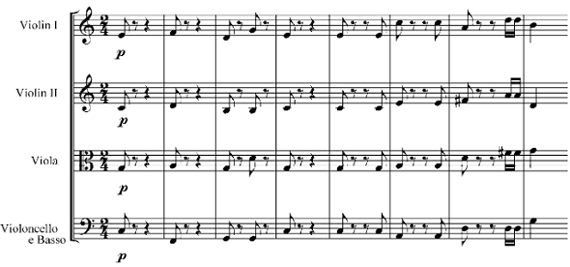
Fig. 3: Die Geschöpfe des Prometheus, op. 43, No. 1 (Poco Adagio)
Prometheus observes, enthralled—then breaks into an outburst of joy: Allegro con brio. The graceful turns, leaps and trills of his music are in sharp contrast to the broken notes that portray the creatures’ clumsy steps.

Fig. 4: Die Geschöpfe des Prometheus, op. 43, No. 1 (Allegro con brio)
That this contrast was intended by Beethoven to denote the movement of the god as opposed to the movement of the creatures, there can be no doubt: on pages 73-75 of the Landsberg 7 sketchbook, he has written above his draft of this scene a bar-by-bar account of the action depicted in the music (Plates IX and X). Each time the chords in separated eighth-notes occur, Beethoven’s commentary is referring to the motions of the humans, while the words describing Prometheus’ actions always appear above the arpeggios and running passages in sixteenth notes (given mostly to the first violins in the score).
The human beings are not yet capable of thought or emotion, however; they remain insensitive to the gift Prometheus has given them. In the second and third numbers Prometheus becomes alternately piteous of and angry with them—at one point he is dissuaded from his intent to destroy them only by a voice from on high that speaks to him inwardly. Finally he decides to bring them to the temple of Apollo on Mount Parnassus, where they can receive education in the arts. This resolve fires him with hope, and the first act closes with an exuberant coda to the third number.
The court of Phoebus Apollo on Mount Parnassus is the setting of the second act of the ballet, designed by Viganò as a vehicle for a series of diverse entertainments. Powerful D-major chords, Maestoso, delineate the splendor and majesty of the scene. (According to Ritorni, Viganò had the novel idea of letting the curtain first rise on the set without either accompanying action or music, so that the spectacle would have the maximum impact on the audience.72 Beethoven’s regal music then underscored the visual effect of the scene—which, however, failed to impress the opening night reviewer.73) Once more recur the broken eighth-note chords: Prometheus leads in the two humans and requests that Apollo acquaint them with the art and skill of the gods in music and dance.
The fifth number opens with harp arpeggios, one of the extremely rare instances of the use of that instrument in a Beethoven score. It sets the level for what is to follow, and represents the divine musician, Apollo himself, summoning celestial tones from his lyre. In the beautiful music which ensues, the creatures are serenaded first by Euterpe, the muse of lyric poetry, accompanied by Amphion (flute solo), and then by Orpheus with Arion (violoncello solo). Terpsichore, muse of the dance, performs a graceful ballet in triple time for them. Then the merry Bacchus and his attendants, together with the armed companions of the god of war, Mars, excite the creatures with a “heroic dance” meant to awake in them a desire for deeds of valor. This design succeeds, as toward the end of the eighth number the creatures take up weapons and join the group in a martial scene that must have resonated with those who were concerned about Napoleon’s advancing armies.
Suddenly the muse of tragedy, Melpomene, enters. She stages a dance revealing to the humans their inevitable destiny—the end of life in death. The creatures are filled with terror and horror. Melpomene flings an accusation at Prometheus: why has he created these unfortunate beings and given birth to such suffering?
The orchestra crescendos depict the sentence pronounced by Melpomene: Prometheus himself must die. There follows a series of sforzando chords—on the last one, Melpomene strikes him with her dagger, and he falls to the ground. The man and the woman are stunned. They react in dazed confusion, and finally they sink, weeping, by their fallen benefactor.
It was this scene which aroused the critics’ indignation at Viganò. They could not accept the hero’s violent death at the hands of a woman taking place on stage.74 For his part, Beethoven seems to have subscribed fully to the concept. In his sketches he marked the appropriate passages “Prom: weint”, “Promethe mort”, “les enfants pleurent”, “Vorwürfe dem Prometheus”, “va in collera”, and once again, “Promet: mort” (see pp. 109-111 of Mikulicz' edition of Landsberg 7). Like the final version, these sketches are all in C minor, and various commentators, including Fishman, Floros, and Maruyama, have pointed out how some of the sketches bear resemblance to passages from the funeral march of the Eroica Symphony.75
Indeed, in the midst of the sketches just referred to, on page 110 of Landsberg 7, Beethoven has inscribed above a staff the word “Sinfonia”, beneath which is a sketch in C minor for what is unquestionably a funeral march.

Fig. 5: Landsberg 7 Sketchbook (tr. K. Mikulicz, 1927), p. 110, lines 5-7
Fishman draws attention to the similarity of its concluding phrase to an 1803 sketch for the Eroica’s Marcia funebre, as transcribed by Gustav Nottebohm:76

Fig. 6: 1801 sketch for Op. 43, No. 9 compared with 1803 sketch for Op. 55/2
One could as easily compare two passages from the finished works: the coda at the end of the ninth number of the ballet and the coda at the end of the Maggiore section of the funeral march in the Third Symphony (bars 101-104):
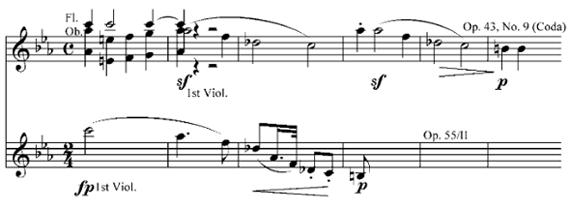
Fig. 7: Op. 43, No. 9 (Coda) compared to Op. 55/2, 101-104
This evidence, standing alone, may be insufficient to sustain any conjecture about the connections between Prometheus’ death music and the second movement of the Third Symphony. It is, however, worth noting the degree to which, according to the evidence of the sketches, funeral music for a fallen hero was occupying Beethoven’s mind at this time: sketches for the third movement of the piano sonata op. 26—the movement entitled “Marcia funebre sulla morte d’un eroe”—both precede and follow in Landsberg 7 the Prometheus death scene sketches described above.
The tenth number of the ballet is a “Pastorale”. By combining Ritorni’s abbreviated account with the program notes, one can surmise that this was the “Schäfertanz” (“dance of the sheep”) mentioned in the latter, the invention of Pan who leads it with his pipes, during which Thalia, the comic muse, dances with her masks in front of the humans to show them that Prometheus’ death was not real, but only staged. The short, introductory eleventh number and the more elaborate one that follows are designated in the working score “Coro di Gioja” and “Solo di Gioja”, respectively. Since Ferdinando Gioja danced the role of Bacchus, we can assume that the short No. 11 served to usher on stage his suite of Bacchantes, followed by his dramatic solo entrance and ensuing dance (No. 12), during which he (or perhaps Pan, at his bidding—see Ritorni’s account, translated in Appendix C) summons Prometheus to arise.
In keeping with the idea of successive “entertainments”, there now follows No. 13 of the ballet, entitled in the working score “Grot[t]eschi Terzettino” (“little trio of grotesques”). The sketches for this number indicate that it consisted of three short solo dances for two men and a woman, interspersed with passages for a group of dancers. In his monograph on the ballet, German musicologist Constantin Floros suggests that this was a type of ballet known at the time (and considered one of its lowest forms) in which peasant types leapt and cavorted grotesquely about, heedless of meter and form.77
The buildup to the climax of the ballet begins with No. 14, the “Solo della Sigra Casentini”, which is specified as following without pause the danse grotesque. Maria Casentini was the dancer who replaced Viganò’s former wife as his company’s female lead; in Prometheus she danced the part of the female brought to life by the Titan. As noted, the opening night’s performance of Prometheus was held for her benefit—presumably to allow her to establish herself in the imperial capital and begin to build a following, as had Madam Viganò.78
In any event, the music of No. 14 consists of an evocative introduction, followed by a languorous Adagio in which Beethoven pairs an oboe with a basset horn—the only instance of this instrument in a Beethoven score. What appears to be portrayed is an awakening of the emotion of love, in which the choreography probably called on Signora Casentini to attempt a little seduction on her male counterpart. The number ends with a sprightly Allegro/Allegretto, 2/4, which could not present a stronger contrast with the halting chords that accompanied Signora Casentini’s first attempts at movement.
The same striking contrast appears in No. 15, a solo for the male figure, danced by Viganò himself. There is an opening flourish as he takes his position, followed by an Adagio in 2/4 in which he responds to the emotions displayed by his partner. (This time the duet is between the clarinet and the bassoon.) As with No. 14, Beethoven then gives him a lively closing Allegro in which to show off all his new-found abilities, and which, as befits the ballet master, is significantly longer and more elaborate than the music for the preceding solo.
And so we come to the finale, No. 16. This is titled simply “Finale” in the working score; with Bacchus, Pan and the two human figures having danced their solos, is this then the occasion for a closing solo from the ballet’s title figure? Nothing would so indicate. The movement is built in rondo form, and the repeated appearances of the celebrated theme are marked in the working score simply as “Thema”, “Tema”, etc. From Ritorni’s brief description,79 “e così fra danze festive termina la favola” (“and thus the story concludes amid festive dances”), as well as from the general practice in such divertissements, it is most likely that the concluding number furnished an occasion for all of the ballet’s principal characters to dance together.
Such an interpretation of the Finale also makes dramatic sense. The fact that it is the human creatures who take over the action at the end of the ballet is significant—in terms of the plot, they have now attained maturity and are capable of experiencing joy and sorrow, love and heroism, as well as showing the capacity to learn from all their experiences. How appropriate, then, for the music to summarize this evolution. The last three numbers represent musically a development of the initial Poco adagio of the ballet’s first number, a compositional feat that parallels the dramatic developments being shown on the stage. Gone are the broken and incomplete lines of the music first used to depict the creatures, just as awkwardness is now absent from their dancing:
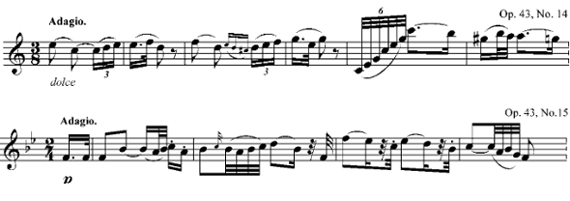
Fig. 8: Die Geschöpfe des Prometheus, op. 43: Solo della Sigra Casentini (No. 14); Solo di Viganò (No. 15)
The culmination of this process, however—the most flowing and graceful of melodies—is reserved for the finale, when the two humans join the gods in a celebratory dance: it is the “Prometheus theme,” the apotheosis of the musical and dramatic development that has occurred in the ballet:

Fig. 9: Prometheus-theme, Op. 43, No. 16 (finale)
Hugo Riemann saw this intuitively when he wrote: “Neither Apollo, nor any of the Muses, nor Bacchus, nor Pan, nor Amphion, nor Orpheus, but the two humans, having been brought to the peak of their development, are the heroes represented in the music.”80
Riemann, however—and Fishman following him—did not pursue this insight far enough. For while it certainly is true that the outstanding progress in music and the arts made by the humans is embodied in the music of the finale, it is equally important that the gods are seen as admitting the humans into their society, by dancing together with them at the end. It is just this particular development that we know would resonate most with Beethoven’s fierce egalitarianism, in which he saw himself, and kindred artists such as Goethe, as fully the equal of any nobility happening to walk the earth, whose advantages he saw as stemming solely from an accident of birth.81 The rondo theme of the finale, in addition to expressing Prometheus’ joy at the success of his creations, and the humans’ delight in their new accomplishments, embodies the entire ideal that with proper instruction and inspiration, the human spirit can soar to heights at which mankind is able to consort with the gods themselves. And it is precisely in this high-principled context, I suggest—the spiritual evolution of the human race to a divine level, enacted through a musical allegory—that one must understand Beethoven’s decision to give this theme a special place in his compositions.
ENDNOTES
66 Haas 1925; Sonnleithner (1861) informs us that the 1843 performance featured added music by Mozart and Haydn—a fact which does not surprise, since as Haas records, the 1843 revival was based on Viganò’s scenario for the 1813 Milan production of the “big Prometheus” in six acts, and for which Viganò required much more music, including some he composed himself (supra, n. 45).
67 See Plates VII and VIII,
68 English translation taken from Senner, Wallace and Meredith (eds.) 1999, pp. 215-16. The text of the original appears in Appendix E.
69 August Kuhn, “Concert in Berlin”, Der Freymüthige 23 (January 1826), 28. Translation from Senner, Wallace and Meredith (eds.) 1999, pp. 216-17.
70 Fishman, vol. III, 47.
71 Most of the German literature on the ballet credits Floros 1978 with the first full analysis of Prometheus, based on a review of all the sources. In fact, however, much of the credit should go to Nathan Fishman, who in pages 46-53 of his commentary (Fishman, vol. III) first showed, using the sketches in Landsberg No. 7, the contrast Beethoven intended between the flowing music for Prometheus and for the first, halting steps of the humans. Fishman also analyzes the sketches for No. 9, where Prometheus is struck down by Melpomene, and for the finale, in which the humans finally evolve to the level of the gods. We owe to Floros the first comprehensive fitting together of all the known sources, in an attempt to reconcile some of Ritorni’s ambiguities with those of the theater program. The analysis that follows, drawn on my 1966 thesis written twelve years before Floros’ monograph, derives (except as noted) mainly from Fishman.
72 Ritorni 1838, at 48 (See Appendix C [beginning of second paragraph]).
73 Opening night review quoted supra.
74 For example, Ritorni (1838) says, at 49 (Plate VIII): “Murder does not become an allegorical goddess, nor is it for Melpomene to be the agent of actual death, but only to act out catastrophes filled with blood. Why not rather depict, after the tragic end of man, the immortal life of the soul, the mercy of the deification of Prometheus, whom it suited Apollo, the god of action, to raise to immortal life?” (“Non conviene a divinità allegorica uccidere, nè a Melpomene dar morte vera, ma imitar vere catastrofi sanguinose. Perchè non rappresentar piuttosto, dopo il tragico fine dell’ uomo, l’immortal vita dell’ anima, mercè l'apoteosi di Prometeo, cui conveniva ad Apollo, nume dell’ azione, innalzar a vita immortale?”)
75 Fishman, vol. III, at 51-52; Floros 1978, at 93-94; Maruyama 1987, at 58-59.
76 Fishman, vol. III, 52.
77 Floros 1978, at 69. The commentary here as to Nos. 10-15 is based on Floros and on my own subsequent research; Fishman’s commentary on them is minimal.
78 While the goal seems to have succeeded to have succeeded financially, it was not a success artistically. As quoted earlier supra, the review described her dancing as “lackluster”; certainly she never captured the enthusiasm of the public as earlier had Madam Viganò. The other opening night review, in the Journal des Luxus und der Moden 16 (Weimar, June 1801), “Briefe über Wien” at 303-07, printing an account dated April 17, 1801, found her solo dancing “lacked character”, and that her expression “at times bordered on the infantile”.
79 See Plate VIII, p. 49.
80 “Weder Apoll noch einer der Musen, noch Bacchus, Pan oder Amphion und Orpheus, sondern die nun auf die Höhe ihrer Entwicklung gebrachten beiden Menschen sind die durch die Musik räpresentierten Helden.” Riemann 1909-10, at 120. Fishman (after quoting Riemann) echoes him (Vol. III, 53): “[In the Prometheus melody, t]he awkwardness disappears, a gracefulness takes its place, the one-syllable motives change into an unbroken, broadly phrased melody which seems to express the general growth of man’s spiritual beauty. . . . It is precisely in this high-principled context of the Prometheus-melody that the reason may be found for Beethoven’s giving it a special place in his piano, ballet and symphonic work.”
81 Stories abound of Beethoven’s behavior toward nobles he thought were regarding him as an inferior; he smashed his bust of Prince Lichnowsky following one such incident (TDR II, 519-20; Thayer-Forbes, 403), and then purportedly wrote the Prince as follows (BGA, No. 258): “Prince, what you are, you are through chance and birth, what I am, I am through my own efforts; there has been and there will be thousands of Princes; but there is only one Beethoven.” (“Fürst, was Sie sind, sind Sie durch Zufall und Geburt, was ich bin, bin ich durch mich; Fürsten hat es und wird es noch Tausende geben; Beethoven gibt’s nur einen.”) On Beethoven’s “nobility pretence”, see Solomon 1998, 117-20; also his earlier article (Solomon 1977).





